|
Junkers Ju 88 C-4
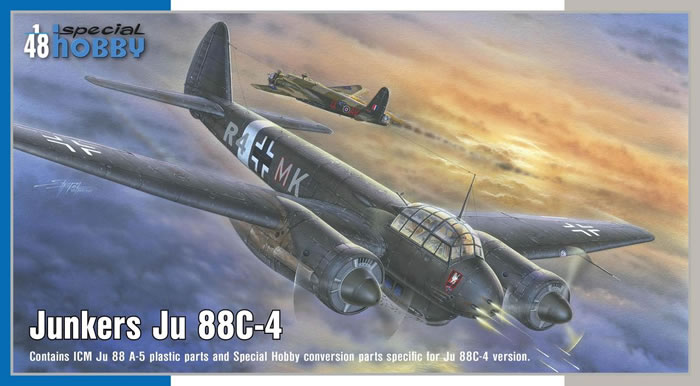
Special Hobby, 1/48 scale
S u m m a r y : |
Catalogue Number: |
Special Hobby Kit No. SH48177 - Junkers Ju 88 C-4 |
Scale: |
1/48 |
Contents & Media |
Eight sprues of grey plastic; two sprues of clear plastic; 24 parts in grey reisn; markings for three aircraft. |
Price: |
Available on-line from these stockists:
Click here for currency conversion |
Review Type: |
First Look. |
Advantages: |
High quality plastic and resin parts; high level of detail; crisp and fine surface textures; comprehensive instructions. |
Disadvantages: |
|
Conclusion: |
It’s great to have a modern tool Ju 88C-4 that can now put the maligned Dragon versions out to pasture, plus the poorly-executed Hobbycraft release. – highly recommended. |
Reviewed by James Hatch

Special Hobby’s Mirage F.1B/BE is available online from Squadron.com
Without a doubt, the Junkers Ju 88 was one of the most versatile and adaptable aircraft to have been used during WWII.
Entering service as the war was literally starting (on the day of the Polish attack), the Ju 88 became successful for its numerous famous and infamous roles, starting out as a light bomber/dive bomber, and when losses started to mount around the time of the Battle of Britain, it was moved into other theatres of war, such as North Africa, and against shipping in the Mediterranean with a torpedo-carrying variant.
Where it is perhaps best known are for its roles as both a heavy fighter and night-fighter, in which it excelled.
The C version, which is the subject of this kit, saw the glass nose replaced with a sheet metal unit, carrying a lethal punch of four fixed guns (1 x MG FF cannon, and 3 x MG17). This was the version which eventually morphed into the deadly Ju 88G, with its revised fin and night-fighting equipment, including spine mounted, upward firing guns and lack of the bola.
Many of the C version machines were built from converted A-1 and A-4 airframes, and still retained the ability to also carry bombs. To deceive enemy fighters, a number of these heavy fighters had their noses painted to represent the glazed nose A variants.
ICM seem to be favourites for other companies to re-box at the moment, with this latest Special Hobby release also being of Ukrainian origin.
ICM’s base kit was first released in 2015, as the A-5, with subsequent ICM and Hasegawa boxings. However, this is the first time that we’ve seen a solid nose C version of this kit. This quirk is due to the majority of the kit being ICM, coupled with new injection-moulded and resin parts from Special Hobby themselves. So, if you want a recently new-tooled Ju 88 that is a night fighter, then this is one you may well opt to buy.
This kit itself is packaged into a fairly large box with an atmospheric artwork of a black 88C at dusk, after an encounter with a Wellington. The lid is quite a tight fit, but when you get this off, the parts within are packaged into a single clear sleeve, with the clear sprue being separately packed. A cardboard shelf sits over one side of the inner box, with the decal sheet and resin parts securely fastened to it, as well as the brand new Special Hobby clear sprue.
An A4 colour-printed instruction manual resides in the bottom of the box. As for the plastic itself, there are SEVEN sprues of light grey ICM plastic and one sprue of ICM clear plastic. This is alongside a single sprue of light grey Special Hobby plastic and one extra clear sprue from this company.
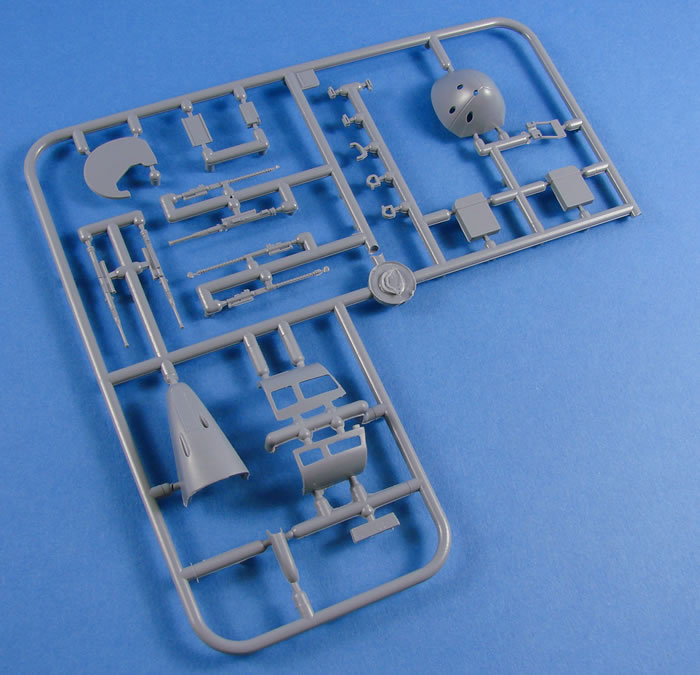
There are also 24 extra parts, cast in dark grey resin.
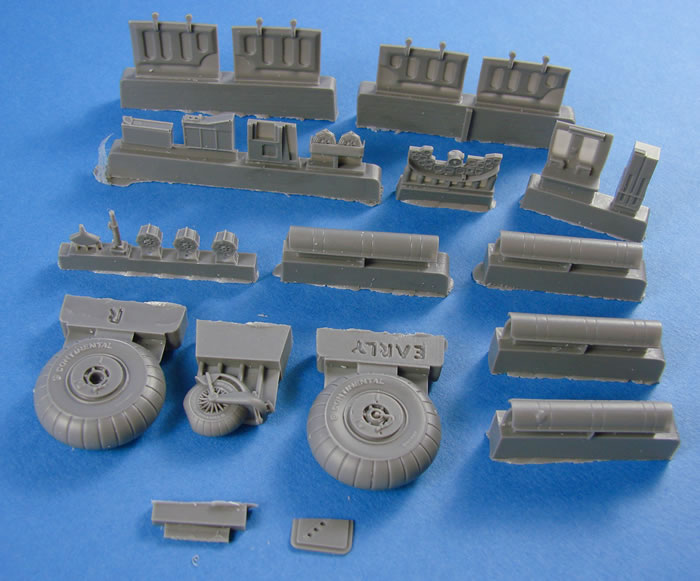
I know that some modellers can be driven to frustration by the engineering choices that some companies make, but with this kit, ICM has boxed clever. It is designed to accommodate other versions so as to maximise the tooling, but none of this is done to the disadvantage of the modeller. Some very intelligent design work can be seen here, such as the fuselage halves being full length, so no need to graft on different nose versions. The fin is also separate, indicating something from the 88G family, maybe.
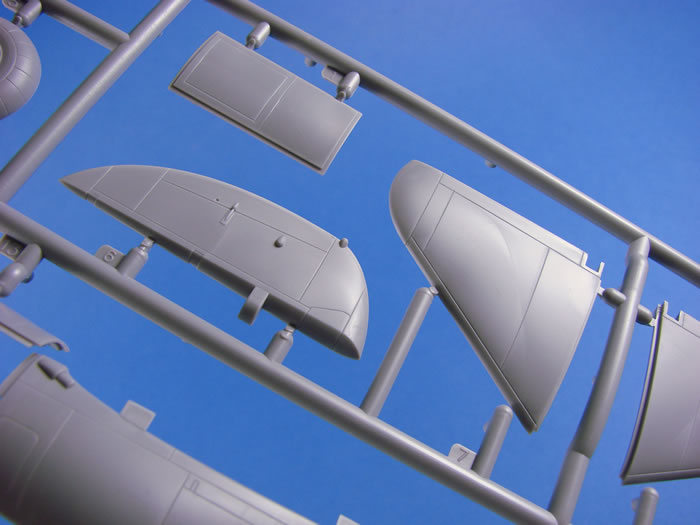
Wing root fairings are moulded to the fuselage and are tabbed, meaning that the upper wing panels can easily sit on these and provide a positive location point.
Another touch of genius is a single piece lower fuse and inboard wing panel section. When this is fitted to the fuselage, and then the wing panels added, the lower seam will be totally hidden under the broad nacelle structure.

The nacelles themselves will then locate into the undersides via tabs. If you’ve ever seen the Revell 1/32 kit, you’ll know that there is a sturdy structure within the nacelle that the undercarriage is mounted to. Looking at this model, I think that whilst you may need to fit that mounting structure prior to the nacelle, it appears that you can probably fit the landing gear later, after painting.
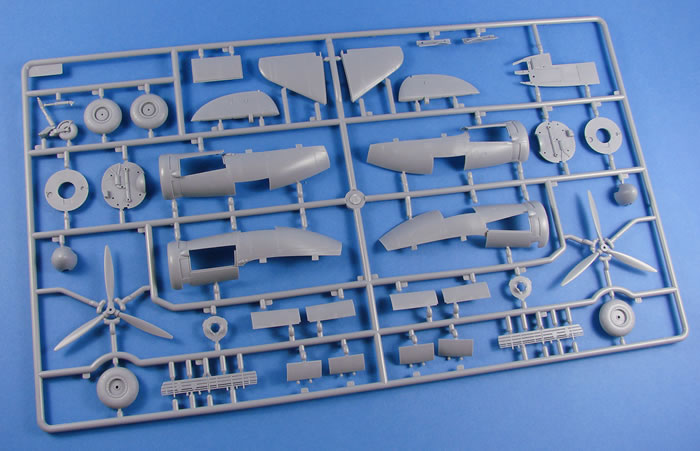
All control surfaces on this model can be posed, with the rear of the nacelles being separate for this purpose. You may need to fiddle things with this, and I can’t comment further without test fitting this one.
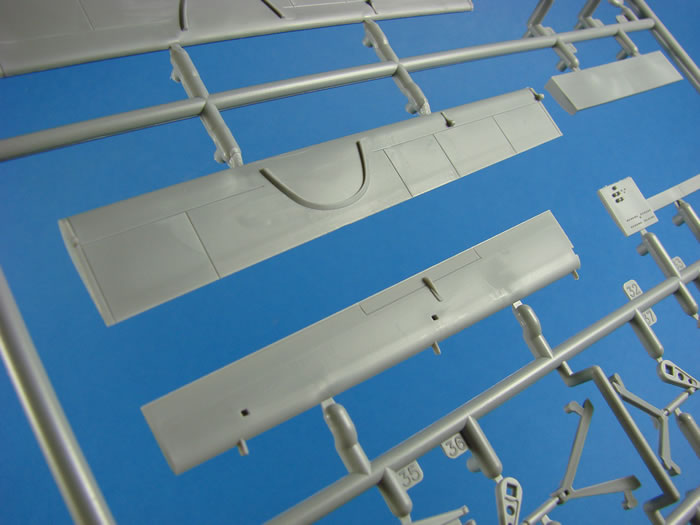
Two detailed Jumo211 engines are included in this kit, with the provision to display one/either of them. These really do look very good, with each unit containing around 15 parts per engine, including the firewall and associated plumbing. One scheme that has standard day splinter camo, will use the plastic kit parts for exhausts. For the other two night schemes, a set of resin exhaust flame dampers are included. It does appear that the rear of the resin flame dampers contains a block that represents the visible connection between the damper and the engine. So, all should be good in opening the cowls with these installed. Check your references.
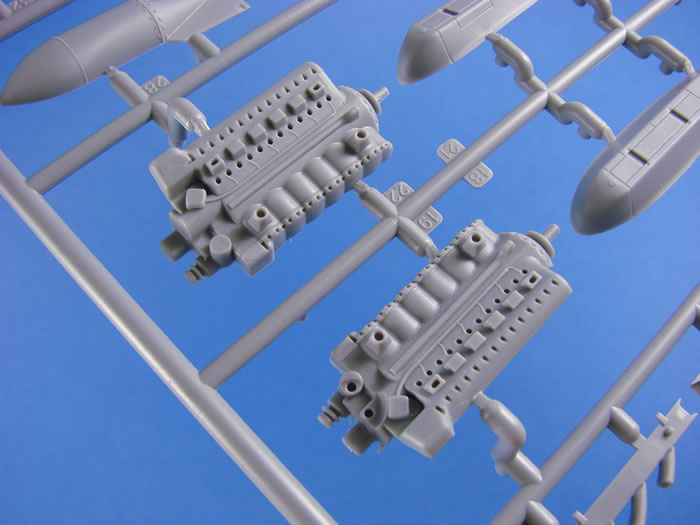
The engines must be installed within the nacelle before the whole assembly is offered to the wing. You’ll need to make sure your painting and masking regime is good here. Cowl radiator flaps are presented as open only, so to pose these in the more aesthetically pleasing closed position, you will need to do a little surgery.
Propellers are supplied as single piece units, and the spinner comprises of the typical back-plate and front section.
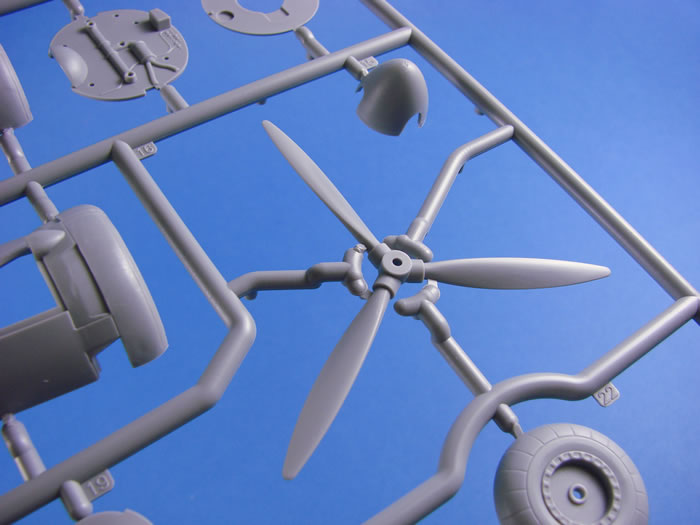
If you expect a lot from the cockpit area, in terms of detail, then this won’t disappoint. Whilst there is no specific Eduard sets for this release at the time of writing, some areas could still use some of the sets designed for the ICM release, but you must remember that this model has a number of cockpit changes. Thankfully, Special Hobby has included these as resin parts, so you don’t need to rush to order aftermarket, except for seatbelts, at least.
The front office is very well-appointed, with nicely moulded fuselage sidewall details, accompanied by a choice of 2 differently equipped radio rear bulkheads, resin ammunition racks and drums (for the forward guns), resin instrument panel, side consoles with delicately rendered instruments, two-piece control column, rudder pedal assemblies, seats with intricate mounting points etc. The other resin parts within this area relate to the nose weapons pack, including another ammunition box, gunner seat and mount, and the gun unit itself. The latter is mostly made up from parts from the new Special Hobby conversion sprue, as is the solid nose and its firewall. When assembled the cockpit will most certainly be a very busy and visual area. The bola gondola is well-appointed too, with a number of resin parts helping to fit it out. This area is moulded separately to the underside fuselage, and can be fitted later in assembly.
***A quick note here…Special Hobby has incorrectly listed the original gondola parts on Sprue A to be used. This is WRONG! Special Hobby’s new sprue has the parts you SHOULD use. This is backed up on the parts plan at the beginning of the manual, but incorrect numbers are shown on assembly***
Surface detail is everything you would expect from a modern-tooled model, with finely engraved panel lines and port details. There are also no rivets at all, so if you do want them, then you’ll have to get out Rosie. Plastic quality here is excellent with no flaws or obtrusive ejector pin marks.
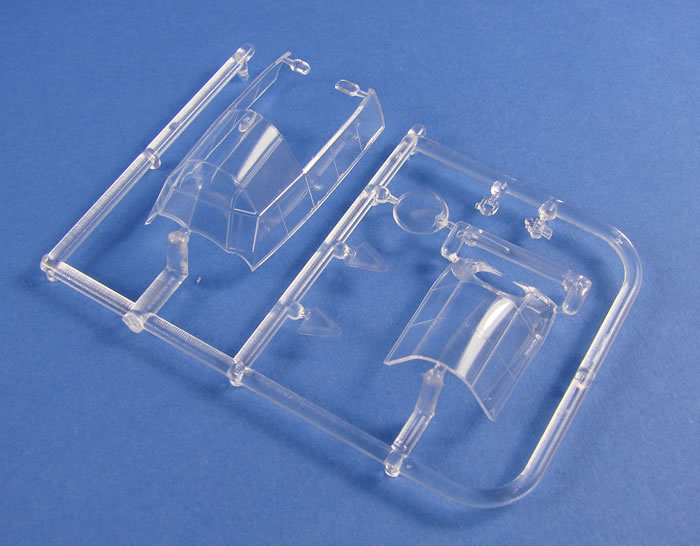
Clear plastic parts, both ICM and Special Hobby, are superb, with excellent clarity and nicely defined frame details.
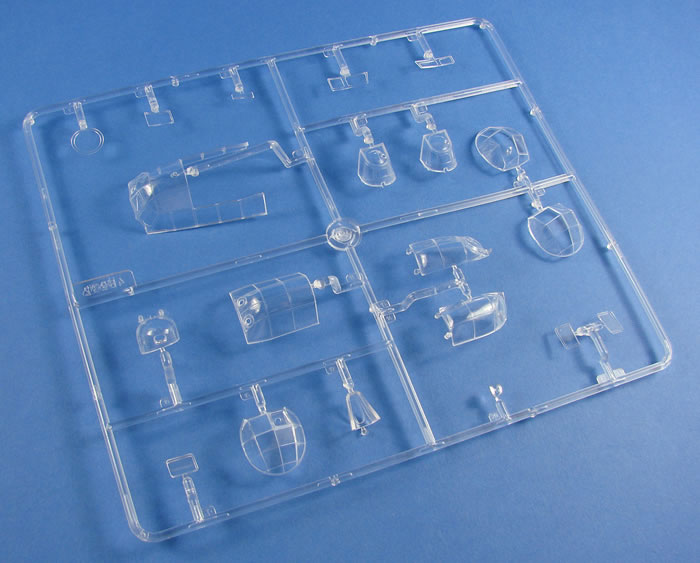
Three options are provided for the rear canopy, with weapon’s placements, and you’ll need to make sure you use the new main canopy provided on the Special Hobby sprue, and not the original ICM part.
Resin
The resin parts in this kit do more than simply provide the aforementioned conversion parts for the C-4. They also provide enhancements over general kit detail, such as nicely weighted wheels, new tailwheel and mudguard, replacement main gear doors with internal detail missing on kit parts. All parts are nicely cast in dark grey resin, with no flaws. Of course, you will need to remove casting blocks, but looking at these pieces, that won’t be too difficult a task for the average modeller.
Marking Options and Decals
A Cartograf-printed decal sheet contains markings for THREE markings, with all printing being in solid, authentic colour, with minimal carrier film and also being both nice and thin. Registration is perfect too.
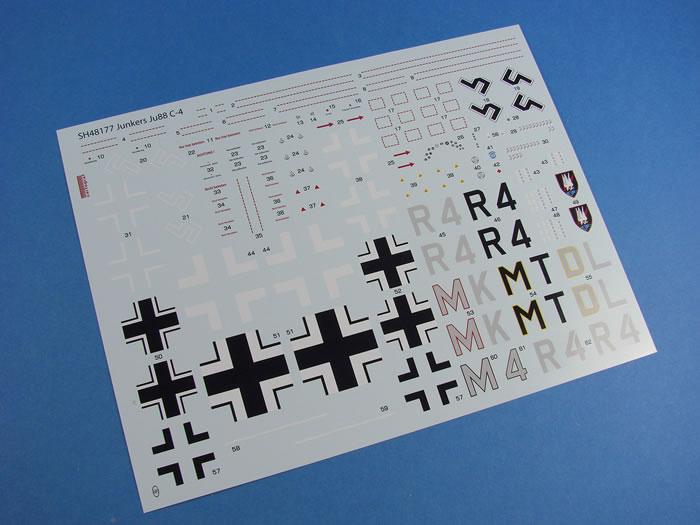
As well as markings, a full suite of stencils are included as are instrument decals. The three schemes are:
-
Ju 88C-4, R4+MK, W.Nr.0359, 2/NJG2, Glize-Rijen, May 1941
-
Ju 88C-4, R4+MT, 9/NJG2, Glize-Rijen, Summer 1942
-
Ju 88C-4, R4+DL, 3/NJG2, Catania, Sicily, May 1942
It’s great to have a modern tool Ju 88C-4 that can now put the maligned Dragon versions out to pasture, plus the poorly-executed Hobbycraft release.
This kit has everything; a great cockpit with resin details, two detailed engines and some nice sub-variant options such as the canopy parts.
I can’t see anything here that would challenge your average modeller, and the price-point is also very attractive, with this kit retailing for around £45 in the UK (as of time of writing).
If you have ever hankered to build the heavy fighter version of the Ju 88, then this blend of both ICM and Special Hobby parts should be high on your purchase list.
Thanks to Special Hobby for the review sample.
Review Text and Images Copyright © 2017 by James Hatch
Page Created 14 March, 2017
Last updated
15 March, 2017
Back to HyperScale Main Page
Back to Reviews Page |
